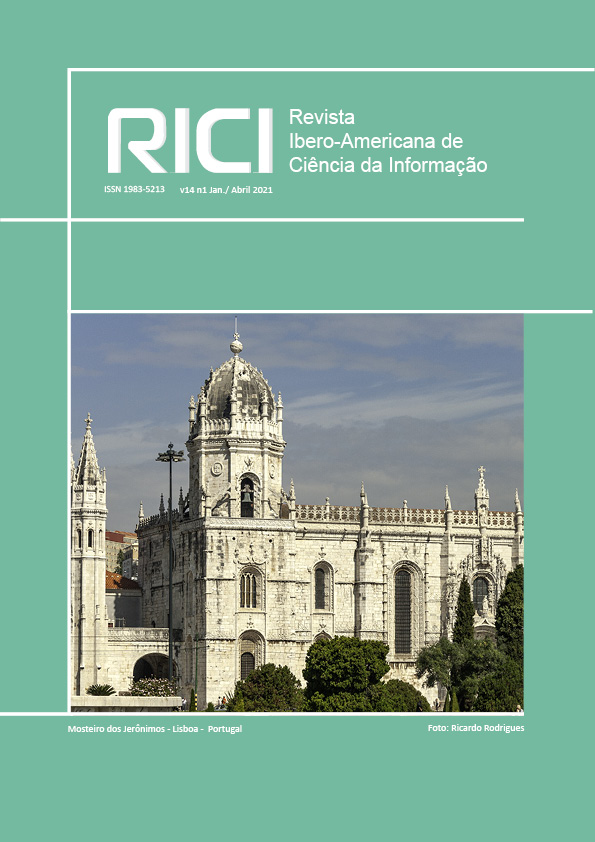Digital texts Interactivity, reading experience and comprehensibility
DOI:
https://doi.org/10.26512/rici.v14.n1.2021.35339Keywords:
Interactivity, Text comprehension, Information behavior, Reading experience, User studiesAbstract
We present the results of a research whose aim is to evaluate the level of comprehensibility of online texts through a survey on the reading experience. The comprehensibility of the information represents a new aspect of information behavior, conditioned by subjective components and characteristics of the reading experience of those who read. We study the effect of the interactivity of the digital text by comparing the reading experience of two texts, both on the subject of physical exercise and differentiated by the level of interactivity, being higher in one case. Thirty-nine people participated in the survey and data were collected on the reading experience, the understanding of the text and its influence on attitudes and opinions, as well as on the global assessment of the two pages. Comprehension of the text was measured based on 14 true and false questions. The data obtained were analyzed through descriptive statistics and, where appropriate, inferential statistics tests were carried out. The only significant difference that was found between the two pages concerns a better comprehensibility of the more interactive page, although the comprehensibility is not related to a greater use of the interactive functionalities in the two pages. Finally, the results show that the consumption of digital text is conditioned by the expectations that readers bring to it and that interactivity is not only a property of the medium but also co-constructed in the interaction between the medium and the readers.
Downloads
References
BUCY, E. P.; TAO, C. C. The mediated moderation model of interactivity. Media Psychology, v. 9, n. 3, p. 647-672, 2007.
COLLINS-THOMPSON, K. Computational assessment of text readability: A survey of current and future research. ITL-International Journal of Applied Linguistics, v. 165, n. 2, p. 97-135, 2014.
FREUND, L; DODSON, S.; KOPAK, R. On Measuring Learning in Search: A Position Paper. En: Search as Learning (SAL), Pisa, Italy, July 21, 2016.
GHOSH, S.; RATH, M.; SHAH, C. Searching as learning: Exploring search behavior and learning outcomes in learning-related tasks. En: CONFERENCE ON HUMAN INFORMATION INTERACTION & RETRIEVAL, CHIIR 18, March 22”“31, 2018. Proceedings. https://doi.org/10.1145/3176349.3176386
HOPPE, A.; HOLTZ, P.; KAMMERER, Y.; YU, R.; DIETZE, S.; EWERTH, R. Current challenges for studying search as learning processes. En: Proceedings of Learning and Education with Web Data, Amsterdam, Netherlands, May 1-4, 2018 (LILE2018).
LIU, H.; LIU, C.; BELKIN, N. J. Investigation of users' knowledge change process in learning”related search tasks. En: Proceedings of the Association for Information Science and Technology, v. 56, n. 1, p. 166-175, 2019.
OH, J.; SUNDAR, S. S. How does interactivity persuade? An experimental test of interactivity on cognitive absorption, elaboration, and attitudes. Journal of Communication, v. 65, n. 2, p. 213-236, 2015.
OH, J.; SUNDAR, S. S. What Happens When You Click and Drag: Unpacking the Relationship between On-Screen Interaction and User Engagement with an Anti-Smoking Website. Health Communication, v. 35, n. 3, p. 269-280, 2020. DOI: 10.1080/10410236.2018.1560578
SOHN, D.; CHOI, S. M. Measuring expected interactivity: Scale development and validation. New media & society, v. 16, n. 5, p. 856-870, 2014.
SUN, Y.; ZHANG, Y.; GWIZDKA, J.; TRACE, C. B. Consumer evaluation of the quality of online health information: Systematic literature review of relevant criteria and indicators. Journal of medical Internet research, v. 21, n. 5, e12522, 2019.
SUNDAR, S. S. Social psychology of interactivity in human-website interaction. En: Oxford handbook of internet psychology. Oxford University Press, 2012.
YANG, F.; SHEN, F. Effects of web interactivity: A meta-analysis. Communication Research, v. 45, n. 5, p. 635-658, 2018.
YANG, F.; Shen, F. Involvement without knowledge gain: A meta-analysis of the cognitive effects of website interactivity. Journal of Broadcasting & Electronic Media, v. 63, n. 2, p. 211-230, 2019.
XU, Q.; SUNDAR, S. S. Interactivity and memory: information processing of interactive versus non-interactive content. Computers in Human Behavior, v. 63, p. 620-629, 2016.
Downloads
Published
How to Cite
Issue
Section
License
Copyright (c) 2020 Michela Montesi, Isabel Villaseñor Rodríguez

This work is licensed under a Creative Commons Attribution 4.0 International License.
Copyright Notice
Authors who publish in this journal agree to the following terms:
- Authors retain copyright and grant the journal right of first publication with the work simultaneously licensed under the Creative Commons Attribution License 4.0, allowing the sharing of work and recognition of the work of authorship and initial publication in this journal.
- Authors are able to take on additional contracts separately, non-exclusive distribution of the version of the paper published in this journal (ex.: distribute to an institutional repository or publish as a book), with an acknowledgment of its initial publication in this journal.
- Authors are permitted and encouraged to distribute their work online (eg.: in institutional repositories or on their website) at any point before or during the editorial process, as it can lead to productive exchanges, as well as increase the impact and citation the published work.
















